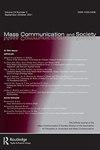The Dynamics of Information-Seeking Repertoires: A Cross-Sectional Latent Class Analysis of Information-Seeking During the COVID-19 Pandemic
IF 2.7
2区 文学
Q1 COMMUNICATION
引用次数: 0
Abstract
ABSTRACTUnderstanding audiences’ information-seeking behaviors during a societal crisis it vital for effective crisis communication. Prior research has identified how individuals combine information sources during a specific crisis phase. However, there is a lack of studies analyzing the stability of such behavior across phases. Therefore, this study utilizes a four-wave panel study conducted in Sweden (N = 13,718) to examine information-seeking repertoires and potential drivers across phases with different threat severity during the COVID-19 pandemic. The results from a cross-sectional latent class analysis revealed four main types of information-seeking repertoires: pluralists, traditionalists, minimalists, and news junkies. Specifically, the findings show that individuals with different socio-demographic profiles broaden their information-seeking repertoire when threat severity is high, making socio-demographic factors a poor predictor of repertoire breadth. Instead, mainstream media trust seems to play a more important role as a potential predictor of broad information-seeking repertoires including non-mainstream sources. The dynamic nature of the repertoires cautions scholars not to make generalization about information-seekers and their characteristics across different phases of a crisis and underline the importance of future research to focus on factors beyond socio-demographics.DisclaimerAs a service to authors and researchers we are providing this version of an accepted manuscript (AM). Copyediting, typesetting, and review of the resulting proofs will be undertaken on this manuscript before final publication of the Version of Record (VoR). During production and pre-press, errors may be discovered which could affect the content, and all legal disclaimers that apply to the journal relate to these versions also. Data availability statementData is available on request from the corresponding author due to privacy/ethics restrictions.Disclosure statementNo potential conflict of interest was reported by the author(s).Notes1 The Swedish Ethical Review Authority gave the panel survey ethical approval on January 15, 2020 (Dnr 2019 –04,339). Every respondent provided written consent to participate before answering the survey..2 The results for the potential drivers thus reflect predicted probabilities⸺not significant regression output..3 The rather low Entropy-value might also be related to the degrees of freedom and the maximum number of class solutions. The Entropy-value might, in other words, have been higher if we had been able to test solutions with more classes. However, there is no agreed cutoff criterion for Entropy, and models with low values might still be theoretically useful (for discussions about this see Muthen, 2008; Weller et al., Citation2020)..4 The socially oriented traditionalists were only captured by the model in wave four. Therefore, it is unknown whether the class has any stable drivers. As a result, the repertoire was excluded from this section.Additional informationFundingThis study is part of the Crisis Communication and Public Trust in a Multi-Public Society (KRISAMS) research project, supported by the Swedish Civil Contingencies Agency under Grant number #2017-2860.Notes on contributorsSofia JohanssonSofia Johansson is a PhD candidate at the Department of Journalism, Media, and Communication at the University of Gothenburg. She holds a master’s degree in strategic communication and a bachelor’s degree in development studies, both from Lund University. Her research focuses on crisis communication from a citizen perceptive. More specifically, she is interested in how individuals combine information sources during a crisis, which functions different sources fulfil, and the underlying motivations and drivers of how individuals construct their information-seeking repertoires. ORCID: 0000-0002-6847-7193Bengt JohanssonBengt Johansson is a professor at the Department of Journalism, Media, and Communication (JMG), University of Gothenburg. He earned his PhD degree in 1998 with his thesis News among us: Municipal news, personal experience, and local opinion formation. He became an associate professor in 2006 and a full professor in 2010. He served as the Director of Graduate Studies from 2000 to 2002 and the Head of the Department of JMG from 2008 to 2011. His research concerns risk and crisis communication, the long-term effects of media on societal beliefs, political advertising, political scandals, and the media coverage of elections. ORCID: 0000-0002-8980-1677Johannes JohanssonJohannes Johansson is a PhD candidate at the Department of Journalism, Media, and Communication’s Varieties of Media Effects research program at the University of Gothenburg. He holds a master’s degree in European studies, politics and public administration from the University of Gothenburg and the University of Konstanz, and a bachelor’s degree in European studies from the University of Gothenburg. His research interests are media-effects and public-opinion via media influence on individual perceptions of society, which he primarily addresses using computational methods. ORCID: 0000-0001-8000-3225信息寻找动态:COVID-19大流行期间信息寻找的横断面潜伏类分析
摘要了解受众在社会危机中的信息寻求行为,对于危机的有效传播至关重要。先前的研究已经确定了个人在特定危机阶段如何组合信息来源。然而,缺乏分析这种行为跨阶段稳定性的研究。因此,本研究利用在瑞典进行的四波面板研究(N = 13,718)来检查COVID-19大流行期间不同威胁严重程度阶段的信息寻求库和潜在驱动因素。横断面潜在类别分析的结果揭示了四种主要类型的信息寻求技能:多元主义者、传统主义者、极简主义者和新闻迷。具体来说,研究结果表明,当威胁严重程度较高时,不同社会人口特征的个体会扩大他们的信息寻求能力,这使得社会人口因素不能很好地预测能力广度。相反,主流媒体信任似乎扮演着更重要的角色,作为包括非主流来源在内的广泛信息寻求库的潜在预测因子。这些曲目的动态性提醒学者们不要对危机不同阶段的信息寻求者及其特征进行概括,并强调未来研究关注社会人口统计学以外因素的重要性。免责声明作为对作者和研究人员的服务,我们提供了这个版本的已接受的手稿(AM)。在最终出版版本记录(VoR)之前,将对该手稿进行编辑、排版和审查。在制作和印前,可能会发现可能影响内容的错误,所有适用于期刊的法律免责声明也与这些版本有关。数据可用性声明由于隐私/道德限制,应通信作者的要求提供数据。披露声明作者未报告潜在的利益冲突。注1瑞典伦理审查局于2020年1月15日给予专家组调查伦理批准(Dnr 2019 -04,339)。每个被调查者在回答调查之前都提供了参与的书面同意因此,潜在驱动因素的结果反映了预测概率,并没有显著的回归输出较低的熵值也可能与自由度和类解的最大数目有关。换句话说,如果我们能够用更多的类来测试解决方案,熵值可能会更高。然而,对于熵没有一致的截止标准,具有低值的模型在理论上可能仍然有用(关于这方面的讨论见Muthen, 2008;3 .韦勒等人,Citation2020)以社会为导向的传统主义者在第四波中才被模型捕获。因此,这个类是否有稳定的驱动程序是未知的。因此,该曲目被排除在本节之外。本研究是多公共社会中的危机沟通和公众信任(KRISAMS)研究项目的一部分,由瑞典民事应急机构资助,资助号为#2017-2860。作者简介:sofia Johansson,瑞典哥德堡大学新闻、媒体和传播系博士研究生。她拥有隆德大学战略传播学硕士学位和发展研究学士学位。她的研究主要集中在危机沟通从公民的感知。更具体地说,她感兴趣的是个体在危机期间如何组合信息源,不同信息源实现的功能,以及个体如何构建信息寻求库的潜在动机和驱动因素。bengt Johansson,瑞典哥德堡大学新闻、媒体与传播系教授。1998年获博士学位,论文为《新闻在我们中间:城市新闻、个人经历与地方舆论形成》。2006年成为副教授,2010年成为正教授。2000年至2002年,他担任研究生院主任;2008年至2011年,他担任JMG系主任。他的研究涉及风险和危机沟通、媒体对社会信仰的长期影响、政治广告、政治丑闻和媒体对选举的报道。johannes Johansson,瑞典哥德堡大学新闻、媒体和传播系媒体效应研究项目博士研究生。他拥有哥德堡大学(University of Gothenburg)和康斯坦茨大学(University of Konstanz)欧洲研究、政治和公共管理硕士学位,以及哥德堡大学(University of Gothenburg)欧洲研究学士学位。 他的研究兴趣是媒体效应和公众舆论,通过媒体影响个人对社会的看法,他主要使用计算方法来解决。ORCID: 0000-0001-8000-3225
本文章由计算机程序翻译,如有差异,请以英文原文为准。
求助全文
约1分钟内获得全文
求助全文
来源期刊

Mass Communication and Society
COMMUNICATION-
CiteScore
6.90
自引率
3.30%
发文量
58
期刊介绍:
Mass Communication and Society" mission is to publish articles from a wide variety of perspectives and approaches that advance mass communication theory, especially at the societal or macrosocial level. It draws heavily from many other disciplines, including sociology, psychology, anthropology, philosophy, law, and history. Methodologically, journal articles employ qualitative and quantitative methods, survey research, ethnography, laboratory experiments, historical methods, and legal analysis.
 求助内容:
求助内容: 应助结果提醒方式:
应助结果提醒方式:


